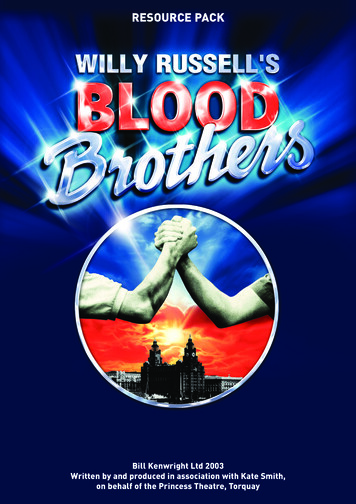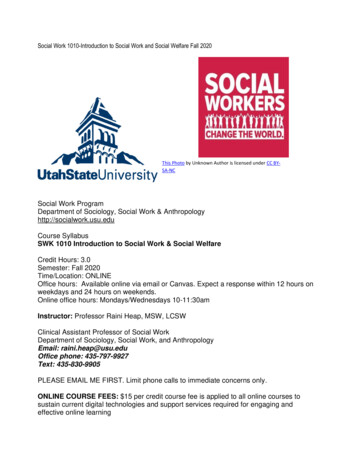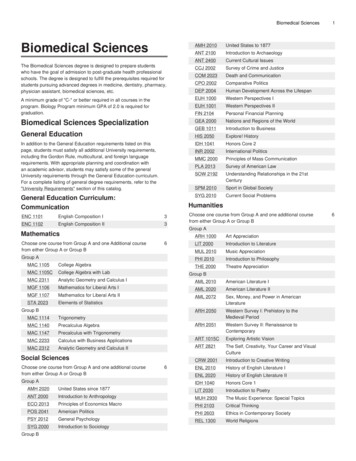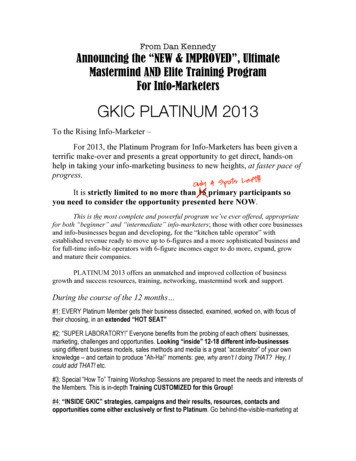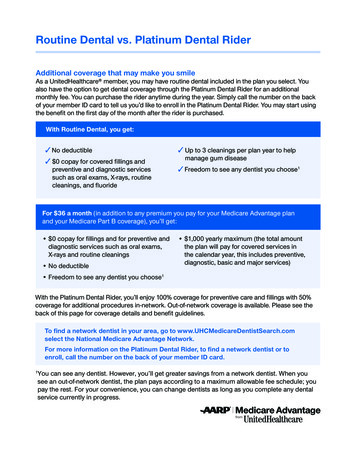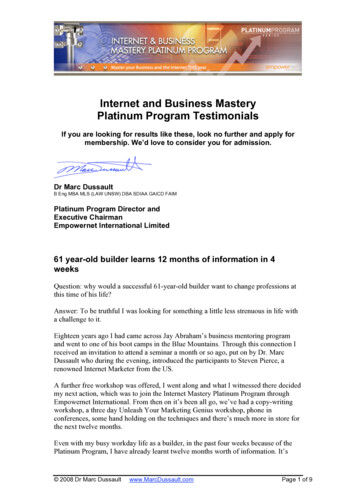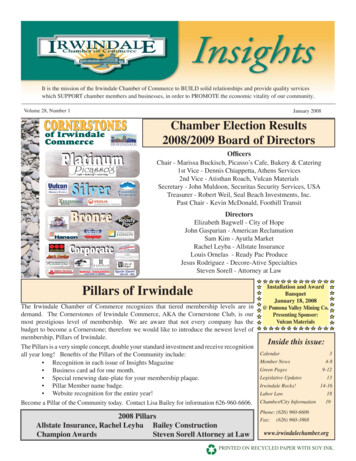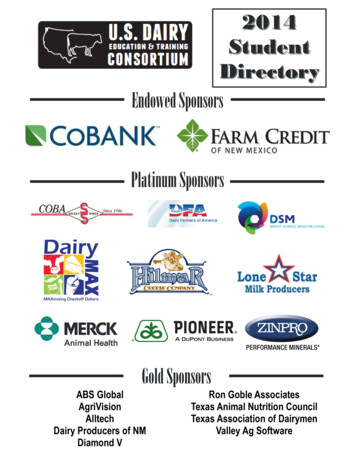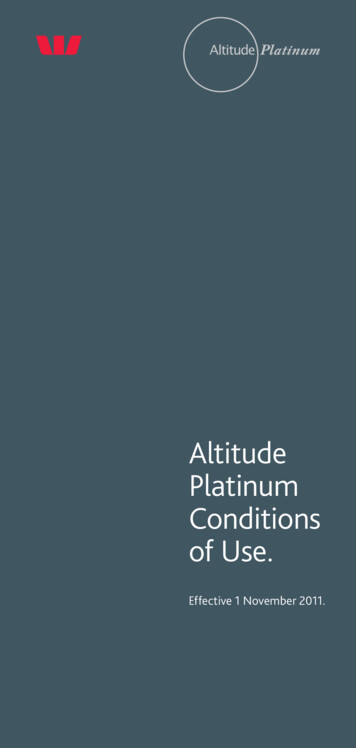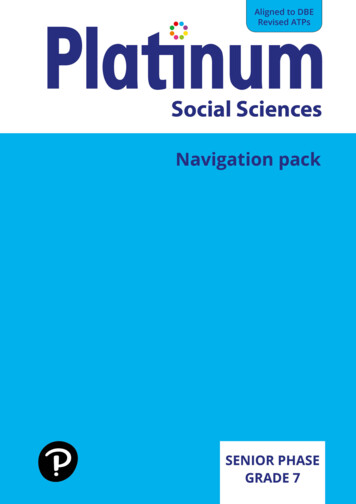
Transcription
Navigation PackSocial SciencesGrade 7SENIOR PHASEGRADE 7
Pearson South Africa (Pty) Ltd4th floor, Auto Atlantic Building, Corner of Hertzog Boulevard and Heerengracht, Cape Town, 8001Offices in Johannesburg, Durban, East London, Polokwane, Bloemfontein, Rustenburg and Mbombela. Pearson South Africa (Pty) Ltd. 2021All Rights Reserved. This digital publication is protected by copyright, and permission should be obtained from thepublisher prior to any prohibited reproduction, storage in a retrieval system, or transmission in any form or by anymeans, electronic, mechanical, photocopying, recording, or otherwise except as authorised for use under the productsubscription through which this digital application is accessed.To request permission to reproduce or adapt any part of this publication, please visit htmlEvery effort has been made to trace the copyright holders of material produced in this title. We would like to apologisefor any infringement of copyright so caused, and copyright holders are requested to contact the publishers in order torectify the matter.Social Sciences Grade 7 Navigation PackPrint ISBN: 9781485720447Print GUID: 7B2D034B-9938-4620-8EB5-9F089FC4C8CEEPDF ISBN: 9781485720409EPDF GUID: FF6AE745-5E96-4742-8DA7-C625838A02F1Cover design by Pearson Media HubTypesetting by The Icon Agency
ContentsDear Teacher . 3Covid 19 Safety Guidelines. 6How to Use. 8Navigation Guide. 9Term 1. 11Term 2. 13Term 3. 15Term 4. 17Targeted Worksheets. 19Targeted Worksheet 1. 20Targeted Worksheet 2. 23Targeted Worksheet 3. 25Targeted Worksheets Answers. 27Exemplar Assessment. 31Geography Mid-Year Exam. 35Geography Term 3 Control Test. 39Geography Final Examination. 37History Mid-Year Exam. 32History Term 3 Control Test. 41History Final-Year Examination. 43Exemplar Assessment Answers . 45Introduction3
4Pearson Navigation Pack
Dear TeacherThe National State of Disaster due to the COVID-19 pandemic has resulted in the disruptionof Education in South Africa and the loss of valuable teaching time and disruption of theschool calendar.As a result of this, the DBE has created and released revised Annual Teaching Plans (ATPs)to assist schools and teachers in ensuring the 2021 school year is completed. The 2021ATPs are based on the revised ATPs that were developed in 2020. It is important to notethat fundamental and core topics are retained in the 2021 ATPs. Some of the strategies thathave been used in the process of developing the 2021 DBE ATPs are: reduction of content covered in certain topicsmerging of topicsdeleting topicsrevising the assessment guidelinesreduction in teaching time for certain topicsresequencing of topics/conceptsAt Pearson South Africa, we believe that education is the key to every individuals’ success.To ensure that despite the challenges, teachers and learners can meet all the necessarylearning outcomes for the year, we have created the Navigation Guide, a free resource tosupport teachers and learners during this challenging time.The Navigation Pack aims to summarise and highlight the changes in the 2021 DBE ATPand provide teachers and learners with worksheets that focus on impacted topics in thecurriculum.Due to resequencing of topics, the order of topics in the textbook that is currently usedin the classroom may not be aligned to the new sequence of topics in the ATP. Pearsonhas included page numbers from one of our tried and tested series, Platinum, to guidethe teacher and learners as they navigate through the textbook, with the 2021 ATP. TheNavigation Pack has a set of assessments based on the Section 4 changes and the revisedassessment guidelines.Introduction5
COVID-19 safety guidelines for teachers andlearnersGatherings at schoolWhere schools are open for learning, it is up to management to take decisive action toensure sites are not simultaneously used for other functions such as shelters or treatmentunits in order to reduce the risk.Implement social distancing practices that may include: A staggered timetable, where teachers and learners do not arrive/leave at the sametime for the beginning and end of the school day.Cancelling any community meetings/events such as assemblies, cake sales, market d y,tuckshop, after-care classes, matric dance, Eisteddfod and other events.Cancelling any extra-mural activities such as ballet classes, swimming lessons, sportgames, music class and other events that create a crowd gathering.Teaching and modeling creating space and avoiding unnecessary touching.Limiting movement and interaction between classes.Schools with an established feeding scheme plan are to ensure that hygiene and socialdistancing is always implemented. Teachers and staff members assisting with fooddistribution are to wear masks, sanitise prior to issuing food items and learners are tostand 1,5m apart in the queue.Wear a mask at all times.1. Restrooms/toiletsHand washingWashing hands with soap and wateror using alcohol-basedhand sanitisers is one of the most important ways to helpeverybody stay healthy at school. Critical to this is preparing andmaintaining handwashing stations with soap and water at the toiletand in each classroom.Teachers and learners should always wash their hands after: 6eatingentering the classroomusing the toiletblowing your nose or coughingtouching tears, mucous, saliva, blood or sweat.Pearson Navigation Pack
2. Premises and classroom settingWhen schools open, classroom settings should be altered in order to promote hygiene,safety and social distancing.Changed classroom settings may include: Cleaning and disinfecting school buildings, classrooms and especially sanitation offacilities at least once a day, particularly surfaces that are touched by many people(railings, lunch tables, sports equipment, door and window handles, toys, teaching andlearning tools etc.).Ensure the proper ventilation and fresh flow of air through classrooms.Providing learners with vital information about how to protect themselves byincorporating the importance of hygiene, handwashing and other measures ofprotecting themselves, into the lessons.Promoting best handwashing and hygiene practices and providing hygiene supplies. Prepare and maintainhandwashing stationswith soap and water,and if possible, placealcohol-based handsanitisers in eachclassroom, at entrancesand exits, and nearlunchrooms and toilets. Ensure teachersand learners wear amask at all times.Social distancing Space the learners outin the classroom (oroutdoors) – try to keeplearners separated by aminimum of 1,5m. Create space forlearner’s desks to be atleast 1,5m apart Learners are not toexceed 30 per class or50% of original classsize Learners shouldnot share cups,eating utensils, orfood Do not let learnerseat items that fallon the floor or chewon pencils or otherobjects Avoid close contact,like shaking hands,hugging or kissingIntroduction7
3. Social behaviourIt is extremely vital during a pandemic that focus is not only directed towards optimalphysical health and hygiene but fi nding ways to facilitate mental health support. Treat everybody with respect and empathy – no teasing about COVID-19. Stay home if you have a temperature or are ill.Encourage kindness towards each other and avoid any stereotyping when talking aboutthe virus.Do not touch people who are ill, but be empathetic.Wear a mask at all times.How to use this Navigation PackRevised DBE Teaching Plan: Comprehensive summary of theCAPS topics according to the revised ATPs.Navigation Plan: Link to thePlatinum series, as well as additionalresources in the Navigation Pack.REVISED DBE ANNUAL TEACHING PLANThemesTopicWAVES, SOUNDAND LIGHTElectromagnetic radiation[9 hrs] *10NAVIGATION PLANUnitTimeLinks to Platinum series and PearsonNavigation PackPage referenceThe nature of electromagneticradiation2 hrsPlat LBPage 84–90The electromagnetic spectrum3 hrsPlat TGPage 46–48The electromagnetic radiation asparticle – Photon4 hrsNavigation Pack: Targeted Worksheet 1Page 15End of year examNavigation Pack: Paper 1 PhysicsPage 45End of year examNavigation Pack: Paper 2 ChemistryPage 56Consolidation and revision16 hrs[16 hrs]HYDROSPHERE *11ASSESSMENTTOTAL HOURS 25*10 This topic has been moved from term 1 to term 4. This topic is on pages 84–90in the Platinum LB, and pages 46–48 in the Platinum teacher’s guide book.*11 The whole topic has been removed.Assessments for the Term as perthe revised ATPs and the Section4 amendments.Footnotes provide any additionalinformation.8Pearson Navigation PackLink to a targeted worksheet inthe Navigation Pack, that focus onimpacted or challenging topics in thecurriculum.Link to an exemplar assessmentin the Navigation Pack, thatwas created with Section 4 andcurriculum changes in mind.
NavigationGuide
Senior PhaseSocial SciencesGeographyTERMGRADE 7GRADE 8GRADE 91Map skills: finding places of intereston a map and using a street map:Merged with other topicsMap skills: No amendmentsTopographic and orthophotomaps:No amendments2Volcanoes, earthquakes, and floods.Case study on earthquakes andfloods - why some communities areat higher risks than others: Mergeinto other topicsClimate regions: NoamendmentsDevelopment issues: World mapindicating the Human DevelopmentIndex (HDI) and Differences indevelopment around the world:Omitted3Population growth and change:Focus on world population growthSettlement: NoamendmentsSurface forces that shape the earth:Sea, moving ice, wind features oferosion and deposition: Omitted4Natural resources and conservationin South Africa: Responsible use ofwater resources and disappearingwetlands: Merge into other topicsTransport and trade: NoamendmentsResource use and sustainability:Over-fishing or over-graving,sustainable fishing or sustainablegrazing, role of consumer: AmendedHistoryTERM123410GRADE 7GRADE 8The kingdom of Mali andthe city of Timbuktu: NoamendmentsThe IndustrialRevolution in Britainand southern Africa: NoamendmentsThe causes and outbreak of WW2 (1919-1945):WW2 in Pacific moved to Term 2The trans-Atlantic slavetrade: Impact of the slavetrade on West Africa,America, Britain: OmittedThe Mineral Revolutionin South Africa: Partsof Gold mining on theWitwatersrand: OmittedThe Nuclear Age and The Cold War: Arms races andspace race details: OmittedColonisation of the Cape17th to 18th centuries:No amendmentsThe scramble forAfrica: Rise of AshantiKingdom: Omitted in the2020 ATP but has beenre-introduced in 2021Turning points in modern South African historysince 1948: Human evolution and commonancestry, racial segregation before apartheid, casestudy Bantustans: OmittedWWI (1914-1918): Reintroduced in the 2021ATPTurning points in South African History (1960, 1976and 1990): Sharpeville Massacre and Formation ofPAC 1959: Moved to Term 3Co-operation andconflict on the frontiersof the Cape Colony in theearly 19th century: NoamendmentsSocial Sciences Navigation GuideGRADE 9Weimar Republic, Sophi Scholl, White Rosemovement, Dietrich Bonhoeffer, Confessing Church,Japan expansion and atrocities in China: OmittedWW2 in Pacific: IncludedTerm 4 Sharpeville Massacre and Formation of PAC1959: IncludedEnd of Cold War: OmittedHelen Joseph or Lillian Ngoyi: Choose between thesetwo
REVISION ANDASSESSMENTSub-topic 4: CurrenteventsUnit 2: Latitude and longitude of places in the news3 hours2 hoursPlatinum LBPlatinum TGPlatinum LBPlatinum TGPlatinum LBPlatinum TGPlatinum LBPlatinum TGUnit 4: Calculating distances on maps (direct andindirect routes)Unit 1: Places in the news on a world mapPlatinum LBPlatinum TGPlatinum LBPlatinum TGUnit 3: Measuring indirect distances on a street map(string and a line scale)4 hoursPlatinum LBPlatinum TGPlatinum LBPlatinum TGPage 23Page 34Page 22Page 33Page 21Pages 32-33Page 19-20Pages 31Page 18Pages 31Page 17Page 30Pages 15-16Page 30Page 13Page 29Page 9-10Page 26Pages 8Pages 26-27Page 6Page 24-25Platinum LBPlatinum TGPlatinum LBPlatinum TGPages 4-5Page 24Page referencePlatinum LBPlatinum TGNavigation guideLinks to Platinumseries and PearsonNavigation PackPlatinum LBPlatinum TGUnit 1: Line scales and word scalesSub-topic 3: Distanceand scale1 hour4 hours4 hoursTimeUnit 2: Different scales for different maps – small andlarge scale mapsSketch map of a local areaUnit 2: Determining and showing compass directionson a local sketch mapUnit 1: Sketching maps to show route from one placeto another[Include Sub-topic 1: Unit 3]Project -50 marksSub-topic 2: Sketchmaps and explainingroutes.Unit 1: Finding home, school and places of intereston a map of local areaSub-topic 1: Local mapsand street mapsGEOGRAPHYTOPIC 1: MAP SKILLS(FOCUS LOCAL MAPS)Unit 2: Using an index and grid to locate places in astreet guide[Combine Units 1 and 2 and teach as one unit.Teach Unit 3 as part of Sub-topic 2. Remove Unit 3:Explaining a route verbally.]Unit/Content specific conceptsSub-topicTEACHER NAVIGATION GUIDETopicREVISED DBE ANNUAL TEACHING PLANSocial Sciences Grade 7Term 1Social Sciences Grade 7 Navigation Guide11
12Sub-topicSocial Sciences Grade 7 Navigation GuideREVISION ANDFORMAL ASSESSMENT50 MARKSSub-topic 3: The city ofTimbuktuSub-topic 2: TheKingdom of MaliHISTORYSub-topic 1: TradeTOPIC 1: THEacross the SaharaKINGDOM OF MALIDesertAND THE CITY OFTIMBUKTU IN THE 14thCENTURYTopicREVISED DBE ANNUAL TEACHING PLANTOTAL HOURS 30Platinum LBPlatinum TGUnit 4: Timbuktu as a centre of learningPlatinum LBPlatinum TGPlatinum LBPlatinum TGUnit 3: Timbuktu as a trade centre on the transSaharan caravan route3 hoursPlatinum LBPlatinum TGPlatinum LBPlatinum TGUnit 2: Leo Africanus’ eyewitness stories of his travels3 hoursPlatinum LBPlatinum TGUnit 3: Construction of the Great MosqueUnit 1: Why the city of Timbuktu flourishedPlatinum LBPlatinum TGPlatinum LBPlatinum TGUnit 2: Mansa Musa’s pilgrimage to Mecca3 hoursPlatinum LBPlatinum TGUnit 4: Sources of information about the pastUnit 1: Mali and the height of its power under MansaMusa early 14th centuryPlatinum LBPlatinum TGUnit 3: Spread of Islam across North Africa and intoWest Africa via traders: 9th centuryPages 126-127Page 96Pages 121-125Pages 93-95Pages 119-120Page 92Pages 117-118Pages 91-92Page 116Page 90Page 115Page 89Page 114Page 89Page 113Page 88Pages 111-112Page 87Page 110Pages 86-87Page 109Page 86Platinum LBPlatinum TGUnit 2: Goods including salt brought from Europeand North Africa into Mali where they wereexchanged for cold, slaves, ivory and ostrich feathersPage referencePage 108Page 853 hoursUnit 1: Camel caravans as a means of transportLinks to Platinumseries and PearsonNavigation PackPlatinum LBPlatinum TGTimeUnit/Content specific conceptsTEACHER NAVIGATION GUIDESocial Sciences Grade 7Term 1
Sub-topic 4: FloodsSub-topic 3:EarthquakesSub-topic 2: VolcanoesUnit 1 Core, mantle and crustSub-topic 1 Structure ofEarthGEOGRAPHY TOPIC 2:VOLCANOES,EARTHQUAKES ANDFLOODSPlatinum LBPlatinum TGPlatinum LBPlatinum TGPlatinum LBPlatinum TGUnit 3: Why some communities are at higher riskthan othersUnit 4: Reducing the impact – preparing for andresponding to floodsUnit 5: Case study of a floodUnit 2: Effects of floodsSocial Sciences Grade 7 Navigation GuidePages 48-49Pages 48-49Page 47Pages 47-48Page 46Page 47Page 45Pages 46-47Platinum LBPlatinum TGPages 41-43Pages 44-45Page 44Pages 45-46Page 25Platinum LBPlatinum TGUnit 6: Case study of the 2010 Haiti earthquakePage 40Pages 43-44Page 39Page 43Page 38Page 42Page 37Page 41Page 36Page 41Page 20Pages 34-35Page 40Pages 32-33Page 39Pages 30-31Page 38Pages 28-29Page 38Page referencePlatinum LBPlatinum TGNavigation Pack:Targeted Worksheet 3Platinum LBPlatinum TGUnit 5: Reducing the impact – preparing for andresponding to earthquakes4 hoursPlatinum LBPlatinum TGUnit 4: Why some communities are at higher riskthan othersUnit 1: Causes of floodsPlatinum LBPlatinum TGUnit 3: Effects of earthquakesPlatinum LBPlatinum TGNavigation Pack:Targeted Worksheet 1Platinum LBPlatinum TGPlatinum LBPlatinum TGPlatinum LBPlatinum TGPlatinum LBPlatinum TGLinks to Platinumseries and PearsonNavigation PackPlatinum LBPlatinum TG4 hours2 hours2 hoursTimeUnit 2: Causes of earthquakesUnit 1 Location of earthquakes around the worldUnit 2: Why volcanoes occurUnit 1: Volcanoes – location around the worldUnit 2 How the crust moves: Introduction to tectonicplates and plate movementUnit/Content specific conceptsSub-topicTEACHER NAVIGATION GUIDETopicREVISED DBE ANNUAL TEACHING PLANSocial Sciences Grade 7Term 213
14Social Sciences Grade 7 Navigation Guide1 hourUnit 1: What was slavery like in West AfricaUnit 1: Plantations: tobacco, rice, sugar cane andcottonSub-topic 2: The natureof slavery in West Africabefore EuropeansSub-topic 3: Slavery inthe American SouthCONTROLLED TESTTERM 1: 15 MARKSTERM 2: 35 MARKSREVISION ANDASSESSMENTTOTAL HOURS 30(Source based questions, paragraph writing)1 hourPlatinum LBPlatinum TGNavigation Pack:Mid year examPlatinum LBPlatinum TGThis topic is removed: see ATPSub-topic 5: Theimpact of the TransAtlantic slave trade oneconomies3 hoursPlatinum LBPlatinum TGUnit 1: What was it like to be a plantation slave in theAmerican SouthSub-topic 4 The impactof the Trans-Atlanticslave trade on slaves2 hoursPlatinum LBPlatinum TGPlatinum LBPlatinum TGPlatinum LBPlatinum TGPlatinum LBPlatinum TGNavigation Pack:Mid year examPlatinum LBPlatinum TGLinks to Platinumseries and PearsonNavigation PackUnit 2: Reasons for using slave labour4 hours2 hoursUnit 1: Slavery in West AfricaSub-topic 1: West Africabefore the Europeanslave tradeHISTORY TOPIC 2:THE TRANS-ATLANTICSLAVE TRADE1 hourTERM 1: 25 MARKSTERM 2: 25 MARKSTimeCONTROLLED TESTUnit/Content specific concepts3 hoursSub-topicTEACHER NAVIGATION GUIDEREVISION ANDASSESSMENTTopicREVISED DBE ANNUAL TEACHING PLANPages 146-159Page 106Page 32Pages 152-153Page 105Pages 140-149Page 101Page 136-139Page 100Pages 132-135Pages 99-100Page 131Page 98Page 130Page 98Page 35Pages 50-51Page 50Page referenceSocial Sciences Grade 7Term 2
Platinum LBPlatinum TGUnit 5: Government policy1 hour2 hoursREVISION ANDASSESSMENTUnit 2: Developments that have affected populationgrowthPlatinum LBPlatinum TGNavigation PackPlatinum LBPlatinum TGPlatinum LBPlatinum TGNavigation Pack:Targeted Worksheet 2Platinum LBPlatinum TGUnit 4: Conflict and wars6 hoursPlatinum LBPlatinum TGUnit 3: Family needs, attitudes and beliefsUnit 1: Pattern of world population growth from 1 ADto present dayPlatinum LBPlatinum TGUnit 2: Economic statusPlatinum LBPlatinum TG3 hoursUnit 1: DiseaseTERM 3 CONTENTTASKSub-topic 3: Worldpopulation growthSub-topic 2: Factorsaffecting birth rates anddeath ratesPlatinum LBPlatinum TGPlatinum LBPlatinum TGUnit 3: Life expectancy2 hoursLinks to Platinumseries and PearsonNavigation PackPlatinum LBPlatinum TGUnit 1: Birth rates, death rats and population growthratesSub-topic 1 PopulationconceptsGEOGRAPHY TOPIC3: POPULATIONGROWTH ANDCHANGETimeUnit 2: Infant mortality ratesUnit/Content specific conceptsSub-topicTEACHER NAVIGATION GUIDETopicREVISED DBE ANNUAL TEACHING PLANPages 76-77Pages 66-68Page 39Pages 69-75Pages 61-65Pages 68Page 61Page 23Pages 66-67Pages 60-61Pages 64-65Pages 59-60Page 63Page 59Pages 61-62Pages 56-58Pages 57-60Pages 55-56Page 56Pages 54-55Page 55Page 54Page 54Pages 53-54Page referenceSocial Sciences Grade 7Term 3Social Sciences Grade 7 Navigation Guide15
16Sub-topic 1: Revise fromGrade 5HISTORY TOPIC 3:COLONISATIONOF THE CAPE 17th 18th CENTURIESSocial Sciences Grade 7 Navigation GuideTOTAL HOURS 301 hourPlatinum LBPlatinum TGUnit 6: Land dispossession and consequences for theindigenous populationREVISION ANDASSESSMENTPlatinum LBPlatinum TGUnit 5 Expanding European frontiersPlatinum LBPlatinum TGNavigation PackPlatinum LBPlatinum TGUnit 4: Free burghers; Dutch and French Huguenotimmigration to the Cape1 hourPlatinum LBPlatinum TGUnit 3: Slaves at the CapePlatinum LBPlatinum TGPlatinum LB PlatinumTGPlatinum LBPlatinum TGLinks to Platinumseries and PearsonNavigation PackPlatinum LBPlatinum TG10 hours2 hoursTimeUnit 2: Results of the arrival of the DutchUnit 1: Reasons for the VOC (DEIC) permanentsettlement of the Cape: 1652Unit 2: Where African farmers settledUnit 1: Indigenous inhabitants of the Cape in the17th centuryUnit/Content specific conceptsTEACHER NAVIGATION GUIDETERM 3 CONTENTTASKSub-topic 2: DutchsettlementSub-topicTopicREVISED DBE ANNUAL TEACHING PLANPage 181Page 114Page 41Pages 178-180Page 113Pages 174-177Page 112Pages 171-173Page 111Pages 164-170Pages 109-111Pages 162-163Pages 108-109Pages 160–161Page 108Pages 158-159Page 107Pages 156-157Page 107Page referenceSocial Sciences Grade 7Term 3
Platinum LBPlatinum TGNavigation GuideNavigation Pack:Final exam1 hourGEOGRAPHY TERM 4EXAMTerm 3:25 marks andTerm 4: 25 marksPlatinum LBPlatinum TGUnit 5: Responsible use of water resources –agriculture, industrial and domestic users2 hoursPlatinum LBPlatinum TGPlatinum LBPlatinum TGUnit 3: River health and the care of catchment areasUnit 4: Disappearing wetlands and why conservationis necessary – case studyPlatinum LBPlatinum TGUnit 2: Availability of water and requirement in SouthAfricaPlatinum LBPlatinum TGPlatinum LBPlatinum TGUnit 4: Eco-tourism - examples4 hoursPlatinum LBPlatinum TGUnit 3: Community conservation project - examplesUnit 1: Who uses South Africa’s water?Platinum LBPlatinum TGUnit 2: Conservation areas – including marinereservesPlatinum LBPlatinum TG5 hoursUnit 1: Concept of conservation – including reasonsfor conservationPlatinum LBPlatinum TGREVISION ANDASSESSMENTSub-topic 3: Water inSouth AfricaSub-topic 2:Management ofresources3 hoursPage 37Pages 104-105Pages 82-83Pages 102-103Pages 80-81Pages 100-101Pages 79-80Pages 98-99Page 79Pages 96-97Pages 78-79Page 95Pages 77-78Pages 93-94Pages 76-77Pages 91-92Pages 75-76Pages 87-90Pages 74-75Page 86Pages 73-74Pages 82-85Pages 72-73Pages 80-82Pages 71-72Links to Platinumseries and Pearson Page referenceNavigation PackPlatinum LBPlatinum TGUnit 1: Natural resources on EarthSub-topic 1: NaturalresourcesGEOGRAPHY TOPIC 4:NATURAL RESOURCESAND CONSERVATION INSOUTH AFRICATimeUnit 2: Use and abuse of selected examplesUnit/Content specific conceptsSub-topicTEACHER NAVIGATION GUIDETopicREVISED DBE ANNUALTEACHING PLANSocial Sciences Grade 7Term 4Social Sciences Grade 7 Navigation Guide17
18Social Sciences Grade 7 Navigation GuideTOTAL HOURS 30Navigation Pack:Final examPlatinum LBPlatinum TGUnit 4: Missionaries and traders1 hourPlatinum LBPlatinum TGUnit 3: The southern borders of the Tswana world:traded ivory, hides, skins, furs, iron and copper withKora and GriquaHISTORY TERM 4 EXAM:50 marksTerm 3:25 marksTerm 4: 25 marksPlatinum LBPlatinum TGUnit 2: Kora and Griqua: traded manufactured goods,tobacco and pack oxen from the CapePlatinum LBPlatinum TGNavigation GuidePage 202Pages 123-124Platinum LBPlatinum TGUnit 1: Expanding trade relationships on the northern 4 hoursfrontier of European settlement2 hoursPages 200-201Pages 122-123Platinum LBPlatinum TGUnit 5: Boers migrate and move into the interior:Great TrekREVISION ANDASSESSMENTSub-topic 3: Thenorthern frontier ofEuropean settlementPlatinum LBPlatinum TGUnit 4: Abolition of slavery 1836Page 43Pages 206-207Page 125Pages 203-205Page 124Page 199Pages 121-122Pages 196-198Pages 120-121Pages 194-195Page 120Page 193Pages 119-120Platinum LBPlatinum TGPages 190-192Pages 118-119Pages 186-189Pages 117-11Unit 3: British immigrationPlatinum LBPlatinum TGPages 184-185Page 116Platinum LBPlatinum TG6 hoursUnit 1: Frontier wars on the eastern frontier ofEuropean settlementSub-topic 2: The easternfrontier of EuropeansettlementPlatinum LBPlatinum TGLinks to Platinumseries and Pearson Page referenceNavigation PackUnit 2: Soldiers and officials2 hoursUnit 1 The British at the Cape in 1795Sub-topic 1: Arrivalof the British and theexpanding frontiersof the EuropeansettlementHISTORY TOPIC 4:CO-OPERATION ANDCONFLICT ON THEFRONTIERS OF THECAPE COLONY IN THEEARLY 19th CENTURYTimeTEACHER NAVIGATION GUIDEUnit/Content specific conceptsSub-topicTopicREVISED DBE ANNUALTEACHING PLANSocial Sciences Grade 7Term 4
TargetedWorksheets
Social Sciences Grade 7Targeted Worksheet 1Targeted WorksheetTopic in CAPS1Topic 2 Sub-topic 3 Earthquakes2Topic 2 Sub-topic 4 Floods3Topic 3 Sub-topic 3 World population growthTopic 2 Sub-topic 3 EarthquakesContent summaryThis topic teaches learners about the structure of the Earth, the causes of earthquakes and theireffects. The sub-topic expands logically on the content of Sub-topic 1: The structure of the Earthand Sub-topic 2: Volcanoes. You can refer to Figure 4 on page 34 of the Learner’s Book, showingthe different tectonic plates. Learners can compare this with Figure 1 on page 32 showingvolcanic areas and Figure 1 on page 36 showing earthquake areas. Point out to learners thatearthquakes occur with more frequency than volcanic eruptions and use the data on page 36 toemphasise the numbers of earthquakes that occur on average each year. Include the content ofUnit 6 here, as an example of an earthquake and its consequences to people living in the area.Use the picture on page 36 to help you and give Activity 1 to learners to complete the unit.Unit 2 delves into the causes of earthquakes. You may need to revise Sub-topic 1 with learnerswho need extra help. You can also point out to learners that inhabitants of Cape Town sometimesfeel mild tremors from movements of the African Plate against the Antarctic Plate. Use Figure 2 onpage 37 to help with your explanation and then give Activity 2 to learners.In Unit 3, learners will examine the effects of earthquakes on people living in an area. The pictureson page 38 will help learners to understand the damage that can be caused by an earthquake.You can briefly include the content of Unit 6, the case study on Haiti, as it is no longer prescribed,as a separate case study. Ask learners to complete Activity 3 on page 38.Unit 4 on the reasons why some communities are at a higher risk than others is no longerprescribed as a separate section but should be included in Unit 5 when describing why it isimportant to prepare for earthquakes in high-risk areas. Disaster management plans and waysof responding after an earthquake are discussed in Unit 5. Use the photographs in Unit 5 todraw attention to the impact of earthquakes. You can also ask learners to think about the impactthat an earthquake will have on a city such as San Francisco, should one occur. If time permits,learners can also research the effects of earthquakes for themselves and find out about recentearthquakes such as the one in Nepal in 2015. Learners should complete Activity 5. Activity 6, thecase study on Haiti can be used as an extension activity if time permits.20Social Sciences Grade 7 Targeted Worksheets
Social Sciences Grade 7Targeted Worksheet 1Time: 40 minutesTopic 2: Sub-topic 3 EarthquakesName:Surname:1. Write only TRUE or FALSE for your answer.a.Earthquakes happen along plate boundaries.b. The Earth’s Crust is strongest where tectonic plates meet.c.Earthquakes at sea can cause tsunamis.d. Japan and New Zealand both experience many earthquakes.e.It is pointless having rescue plans for earthquakes as they are unpredictable. (5)2. Complete the sentences by filling in the blanks.a.A force of energy that shakes the ground is an .b. A crack or weak point in the Earth’s crust is known as a .c.is a serious disease, which causes diarrhoea and vomiting.d. Earthquakes happen along boundaries.e.Shock waves that happen when tectonic plates collide can cause . (5)3. List THREE factors that will determine the extent to which an earthquake affects peopleliving in the area. (3)4. Explain TWO ways in which the impact of an earthquake can be reduced. (2)5. Why is it advisable to move to higher ground when a tsunami occurs? (2)6. Briefly describe how a tsunami occurs and explain its possible effects. (3)7. Refer to the map on page 41 of your Learner’s Book.a.Name the tectonic plate on which Haiti is situated. (1)b. Give a reason why you think the earthquake of 2010 occurred. (1)8. Read the case study on Haiti on pages 41-42 carefully.a.Explain one reason why people living in Port au Prince were so badly affected by theearthquake. b. Describe two ways in which the people of Haiti could reduce the impact of any futureearthquakes. 9. How do people in New Zealand prepare for the effects of an earthquake? (1)(2)(1)10. Read the following passage and answer the questions that follow.Indian Ocean TsunamiOn the 26 Decembe
ASSESSMENT End of year exam Navigation Pack: Paper 1 Physics Page 45 End of year exam Navigation Pack: Paper 2 Chemistry Page 56 TOTAL HOURS 25 *10 This topic has been moved from term 1 to term 4. This topic is on pages 84–90 in the Platinum LB, and pages 46–48 in the Platinum te
